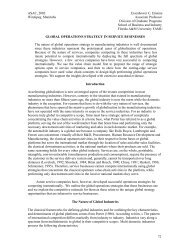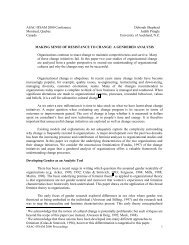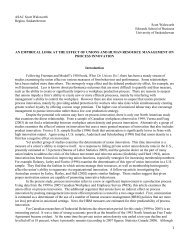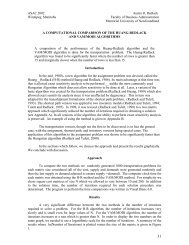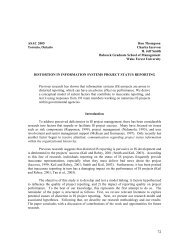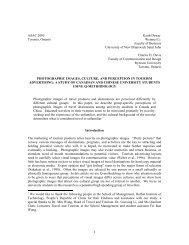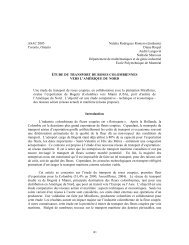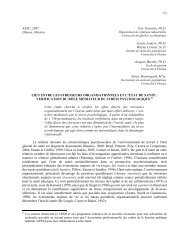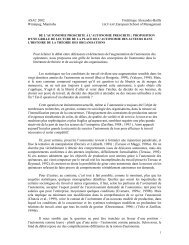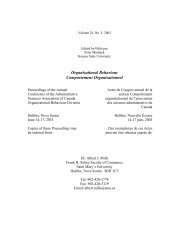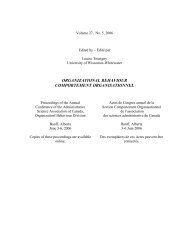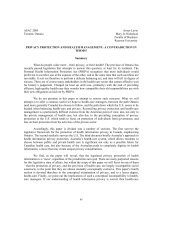the best probability model for the exacta
the best probability model for the exacta
the best probability model for the exacta
You also want an ePaper? Increase the reach of your titles
YUMPU automatically turns print PDFs into web optimized ePapers that Google loves.
ASAC 2005 Conference L.M. Gibson (student)<br />
Toronto, Ontario E.S. Rosenbloom<br />
I.H. Asper School of Business<br />
University of Manitoba<br />
THE BEST PROBABILITY MODEL FOR THE EXACTA<br />
The most heavily wagered bet at <strong>the</strong> racetrack is <strong>the</strong> <strong>exacta</strong>, which looks at <strong>the</strong> top two<br />
horses to cross <strong>the</strong> finish line in <strong>the</strong> exact order. The success of this bet depends on<br />
<strong>the</strong> <strong>probability</strong> that <strong>the</strong> two horses chosen to win and place are correct. It is<br />
commonly assumed in literature that data from <strong>the</strong> win pool, in association with such<br />
<strong>model</strong>s as Harville (1973) or Henery (1981) provide more accurate subjective<br />
probabilities of <strong>the</strong> <strong>exacta</strong> outcome than <strong>the</strong> data from <strong>the</strong> <strong>exacta</strong> pool. Ziemba and<br />
Hausch (1985) and Asch and Quandt (1987) use this assumption to find wagers with<br />
<strong>the</strong>oretical positive expectation in <strong>the</strong> <strong>exacta</strong> pool. In this paper, an SPRT-like test is<br />
used to test this supposition. Results establish that this assumption is false: data from<br />
<strong>the</strong> <strong>exacta</strong> pool provides <strong>the</strong> most accurate estimate of <strong>exacta</strong> probabilities.<br />
Introduction<br />
All bets at North American racetracks are placed under a pari-mutuel system, developed in <strong>the</strong><br />
late 19 th century by Pierre Oller, whereby winners divide <strong>the</strong> total amount bet, after deducting<br />
track operating expenses, racing purses and taxes, in proportion to individual wagers. Under<br />
this system, players bet against each o<strong>the</strong>r, not <strong>the</strong> racetrack and consequently ‘beat <strong>the</strong> races’<br />
only when <strong>the</strong>y ‘beat <strong>the</strong> crowd.’<br />
The <strong>exacta</strong> wager has replaced <strong>the</strong> win bet in terms of popularity in recent years, accounting <strong>for</strong><br />
approximately 30% of total bets placed at <strong>the</strong> racetrack (www.churchhilldowns.com). One<br />
suggestion <strong>for</strong> its popularity is <strong>the</strong> notion of ‘smart money’: those who have inside in<strong>for</strong>mation<br />
will avoid straight wagers where odds are continuously displayed on <strong>the</strong> tote board and instead<br />
place <strong>the</strong>ir wagers in <strong>the</strong> <strong>exacta</strong> pool where odds are displayed less frequently. In order to<br />
capitalize on <strong>the</strong>se apparent inefficiencies however, an accurate estimate of <strong>the</strong> win and place<br />
combination yielding <strong>the</strong> highest <strong>probability</strong> will help to facilitate positive returns. The<br />
objective thus becomes to determine <strong>the</strong> method that calculates <strong>the</strong> most accurate probabilities<br />
<strong>for</strong> win and place combinations.<br />
Past literature including Ziemba and Hausch (1985) and Asch and Quandt (1987) state that win<br />
pool probabilities are reasonably accurate estimates <strong>for</strong> win bets and <strong>the</strong>re<strong>for</strong>e <strong>the</strong> parallel can<br />
be drawn that win probabilities, alongside <strong>model</strong>s such as Harville (1973) or Henery (1981), can<br />
be applied to <strong>the</strong> <strong>exacta</strong> pool (in addition to place, show, quinella and triactor) to capitalize on<br />
inefficiencies.<br />
Be<strong>for</strong>e accepting this viewpoint however, it is valuable to question <strong>the</strong> assumption that win<br />
probabilities can be used to estimate win bets reasonably well. This assumption is largely based<br />
on <strong>the</strong> observation that horses that have fraction ‘p’ of <strong>the</strong> win pool, win approximately fraction<br />
‘p’ of <strong>the</strong> races. To support this assumption would be equivalent to assuming that because it<br />
32
snows 36 days a year in Winnipeg, <strong>the</strong> <strong>probability</strong> of snow on any given day is 10% even on a<br />
day in July. This debate aside however, <strong>the</strong> overall notion that win probabilities are more<br />
accurate than <strong>the</strong> probabilities generated from <strong>the</strong> <strong>exacta</strong> pool is also questionable. This<br />
supposition is explored, and in doing so is <strong>the</strong> first to empirically test <strong>the</strong> Harville and Henery<br />
<strong>model</strong>s against <strong>the</strong> probabilities produced from <strong>the</strong> <strong>exacta</strong> pool. Specifically, this paper<br />
compares three methods from which <strong>exacta</strong> probabilities can be calculated, namely Harville;<br />
Henery; and <strong>the</strong> <strong>exacta</strong> pool to determine which <strong>model</strong> is statistically <strong>best</strong>.<br />
The Harville Model<br />
The Harville <strong>model</strong> is <strong>the</strong> simplest and probably <strong>the</strong> most commonly used <strong>model</strong> by academics<br />
and bettors alike. This method calculates <strong>the</strong> <strong>probability</strong> <strong>for</strong> <strong>exacta</strong> combinations in terms of<br />
win probabilities only. This <strong>model</strong> assumes that if horse ‘i’ wins <strong>the</strong> race, <strong>the</strong> conditional<br />
<strong>probability</strong> of horse ‘j’ coming in second is given by<br />
Pj|i = Pj / 1-Pi (1)<br />
where Pi and Pj are <strong>the</strong> probabilities of horse ‘i’ and ‘j’ winning <strong>the</strong> race. The <strong>probability</strong> of a<br />
horse winning <strong>the</strong> race is estimated by using <strong>the</strong> fraction of <strong>the</strong> win pool bet on that horse.<br />
Combining this with <strong>the</strong> win <strong>probability</strong> <strong>for</strong> <strong>the</strong> first place horse, <strong>the</strong> <strong>probability</strong> of an i-j <strong>exacta</strong><br />
becomes<br />
Pij = PiPj /(1-Pi) (2)<br />
To illustrate <strong>the</strong> above <strong>for</strong>mula, consider <strong>the</strong> following data from <strong>the</strong> 9 th race at Belmont Park on<br />
Sunday September 26 th , 2004:<br />
Wager Winning<br />
Type Number Paid Pool Win Take<br />
Exacta 2-3 $26.00 $270,499.00 14.00%<br />
From <strong>the</strong> above data, Pij can be calculated:<br />
Horse No. Odds Breakage Pj<br />
2 0.30 0.025 0.649<br />
3 30.75 0.125 0.027<br />
P23 = (.649)(.027) / (1-.649) = 0.049899<br />
The Harville <strong>for</strong>mula is a natural and obvious way of estimating <strong>the</strong> <strong>probability</strong> of an <strong>exacta</strong>.<br />
However, <strong>the</strong>re are problems with this <strong>model</strong>. There is a long-shot bias associated with this<br />
method: long-shots tend to be over bet while favorites tend to be under bet. In response,<br />
Ziemba and Hausch developed a ‘corrected’ Harville <strong>for</strong>mula. The Harville <strong>for</strong>mula is<br />
consistent with <strong>the</strong> running times of <strong>the</strong> horses <strong>for</strong> a race following independent exponential<br />
distributions. While <strong>the</strong> independence assumption may be reasonable, empirical distributions<br />
are far from exponential.<br />
33
The Henery Model<br />
Henery (1981) makes <strong>the</strong> more logical assumption that running times are independent normal<br />
with unit variance (i.e. <strong>the</strong> time <strong>for</strong> horse ‘i’ is normally distributed with mean θi and standard<br />
deviation 1. Un<strong>for</strong>tunately, with this assumption <strong>the</strong>re is no closed <strong>for</strong>m solution to <strong>the</strong><br />
<strong>probability</strong> of <strong>the</strong> i-j <strong>exacta</strong>, Pij. However, Pij can be approximated. In doing so, θi must be<br />
estimated by solving <strong>the</strong> equation<br />
Pi = Φ(z0 + θiμ1,n/((n-1)ϕ(z0))) (3)<br />
<strong>for</strong> θi where Φ is <strong>the</strong> cumulative distribution function <strong>for</strong> <strong>the</strong> standard normal, ϕ is <strong>the</strong> density<br />
function of <strong>the</strong> standard normal, n is <strong>the</strong> number of betting entries in <strong>the</strong> race, μi,n is <strong>the</strong><br />
expected value of <strong>the</strong> i-th standard normal order statistic in a sample size of n and z0 = Φ -1 (1/n).<br />
Teichroew (1956) developed tables that approximated μi,n <strong>for</strong> n up to 20. After all θi are<br />
estimated, Pij can be approximated by<br />
Where<br />
And<br />
Pij = Φ[a + γ{θi μ1,n +θj μ2,n +(θi+ θj)( μ1,n+μ2,n)/(n-2)}] (4)<br />
a = Φ -1 (1/(n(n-1)))<br />
γ = 1/(n(n-1) ϕ(a))<br />
Finally, to satisfy <strong>the</strong> fact that <strong>the</strong> sum of <strong>the</strong> probabilities should add up to one, <strong>the</strong> Pij’s need to<br />
be normalized.<br />
Consider <strong>the</strong> following numerical example from <strong>the</strong> 9 th race at Belmont Park on Sunday<br />
September 26, 2004:<br />
where<br />
Finish Odds Breakage Probability<br />
1 0.30 0.025 0.626<br />
2 30.75 0.125 0.026<br />
3 7.10 0.050 0.102<br />
4 5.60 0.050 0.125<br />
5 13.70 0.050 0.056<br />
6 19.60 0.050 0.040<br />
n 6<br />
Z0 -0.96742<br />
MU1,n -1.2672<br />
MU2,n -0.64175<br />
Phi(Z0) 0.249851<br />
a -1.83391<br />
gamma 0.449042<br />
1 2 3 4 5 6<br />
34
1 0.087 0.151 0.165 0.118 0.103<br />
2 0.024 0.003 0.003 0.002 0.001<br />
3 0.071 0.005 0.014 0.008 0.007<br />
4 0.085 0.007 0.016 0.010 0.008<br />
5 0.044 0.002 0.006 0.008 0.003<br />
6 0.034 0.002 0.005 0.005 0.003<br />
Pij = 0.087<br />
Using data from Hong Kong, Lo and Bacon-Shone (1994) found that <strong>the</strong> Henery <strong>model</strong> is more<br />
accurate than <strong>the</strong> Harville <strong>model</strong>. However, likely due to <strong>the</strong> fact that <strong>the</strong> Henery <strong>model</strong> is so<br />
complex, it has rarely been implemented.<br />
The Exacta Pool Model<br />
A third possible <strong>model</strong> is to assume that <strong>the</strong> <strong>probability</strong> of <strong>the</strong> i-j <strong>exacta</strong> is given by <strong>the</strong> fraction<br />
of <strong>the</strong> <strong>exacta</strong> pool bet on <strong>the</strong> i-j <strong>exacta</strong>. In effect, this assumes <strong>the</strong> <strong>exacta</strong> pool is an efficient<br />
market. Surprisingly this very simple <strong>model</strong> has been assumed to be inaccurate. Ziemba and<br />
Hausch provided a number of common sense arguments why this <strong>model</strong> should be inaccurate<br />
including “wheel” and “box” bets. Many bettors make a “wheel” bet where <strong>the</strong> wager includes<br />
every combination, with a favorite in <strong>the</strong> first position of <strong>the</strong> <strong>exacta</strong> bet. It can be argued that<br />
with wheel bets, combinations with a favorite in <strong>the</strong> first position and a long-shot in <strong>the</strong> second<br />
position are over-bet. Ano<strong>the</strong>r popular bet is <strong>the</strong> “box” bet. If a bettor believes <strong>the</strong> <strong>best</strong> three<br />
horses in order are A,B and C, <strong>the</strong>n <strong>the</strong> bettor makes equal bets on all <strong>exacta</strong> combinations<br />
involving A,B and C. The result is that even though <strong>the</strong> bettor believes <strong>the</strong> AB <strong>exacta</strong> is more<br />
likely than <strong>the</strong> CB <strong>exacta</strong>, <strong>the</strong> bettor makes equal wagers on <strong>the</strong>se combinations and <strong>the</strong>re<strong>for</strong>e<br />
distorts <strong>the</strong> <strong>exacta</strong> pool. While <strong>the</strong>se arguments are logical <strong>the</strong>re has never been an empirical test<br />
of this argument.<br />
To illustrate <strong>the</strong> calculation <strong>for</strong> <strong>the</strong> <strong>exacta</strong> pool <strong>probability</strong>, consider <strong>the</strong> following example.<br />
Wager Winning<br />
Exacta<br />
Type Number Paid Breakage Pool Take<br />
Exacta 2-3 $26.00 $0.10 $270,499.00 17.50%<br />
An SPRT-Like Test<br />
P23 = (1-17.5) / (((26.00 + .10 -2)/2)-1) = 0.063218<br />
The Henery <strong>model</strong>, Harville <strong>model</strong> and Exacta pool <strong>model</strong> represent three multinomial<br />
parameter estimation procedures when only one observation per race is possible but <strong>the</strong> three<br />
estimation procedures can be repeated many times <strong>for</strong> different races. An SPRT-like procedure<br />
was developed by Rosenbloom (2000) in order to select <strong>the</strong> <strong>best</strong> of k multinomial parameter<br />
estimation procedures.<br />
•<br />
•<br />
• The underlying multi-hypo<strong>the</strong>sis test is as follows:<br />
35
H1: Henery <strong>model</strong> probabilities are correct<br />
Versus<br />
H2: Harville <strong>model</strong> probabilities are correct<br />
Versus<br />
H3: The <strong>exacta</strong> pool probabilities are correct<br />
The SPRT-Like procedure uses <strong>the</strong> likelihood ratios to calculate <strong>the</strong> posterior probabilities <strong>for</strong><br />
each of <strong>the</strong>se <strong>model</strong>s being correct (assuming one of <strong>the</strong> <strong>model</strong>s is correct) and terminates when<br />
one of <strong>the</strong> posterior probabilities is at least 1-α where α is <strong>the</strong> significance level of <strong>the</strong> test.<br />
Specifically, let<br />
Lj,t = Likelihood under Hypo<strong>the</strong>sis Hj of obtaining data x1 ,x2, …, xt,<br />
BBj = Prior <strong>probability</strong> that <strong>probability</strong> <strong>for</strong>ecasting <strong>model</strong> j is correct (typically a uni<strong>for</strong>m prior is<br />
assumed), and<br />
Rj,t = Posterior or revised <strong>probability</strong> that <strong>probability</strong> <strong>for</strong>ecasting <strong>model</strong> j is correct after<br />
data x1 ,x2, …, xt.<br />
Rj,t is obtained by Bayes’ <strong>for</strong>mula<br />
R j,<br />
t<br />
B j L j,<br />
t<br />
= K<br />
B L<br />
. (5)<br />
∑<br />
i=<br />
1<br />
which can be rewritten <strong>for</strong> computational purposes as<br />
R<br />
j,<br />
t<br />
= K<br />
∑<br />
i=<br />
1<br />
i<br />
j<br />
1<br />
i<br />
i,<br />
t<br />
( B / B )( L / L<br />
i,<br />
t<br />
j,<br />
t<br />
. (6)<br />
)<br />
• Since prior to collecting data <strong>the</strong>re was no reason to prefer any of <strong>the</strong> <strong>model</strong>s, a uni<strong>for</strong>m prior was assumed. That is<br />
R<br />
j,<br />
t<br />
= K<br />
∑<br />
i=<br />
1<br />
( L<br />
i,<br />
t<br />
/ L<br />
The resulting SPRT-like test is as follows:<br />
1<br />
j,<br />
t<br />
. (7)<br />
)<br />
The significance level α was set equal to α = 0.01 and <strong>the</strong> maximum sample size M was<br />
set equal to 1,000. If <strong>the</strong> maximum sample size is reached <strong>the</strong> test is inconclusive.<br />
Data was collected from Belmont Park beginning with <strong>the</strong> first race on Sunday<br />
September 26 th , 2004 and continued each race <strong>the</strong>reafter until <strong>the</strong> experiment<br />
concluded.<br />
After each race, <strong>the</strong> <strong>exacta</strong> <strong>probability</strong> was calculated <strong>for</strong> each of <strong>the</strong> three methods<br />
under consideration, namely Harville, Henery and Exacta Pool. The likelihood ratios<br />
and revised probabilities were updated.<br />
Once a revised <strong>probability</strong> is above 1-α, or 0.99, <strong>the</strong> associated hypo<strong>the</strong>sis was<br />
accepted.<br />
36
The data from <strong>the</strong> experiment is contained in <strong>the</strong> following table (Table 1):<br />
TABLE 1<br />
Belmont Park Data Set<br />
P12-<br />
Revised Prob Revised Prob Revised Prob<br />
n P12-H E P12- He Lh/Le Lh/Lhe Le/Lhe Exacta Henery<br />
Harville<br />
1 0.046 0.029 0.042 1.590 1.091 0.686 0.247 0.360 0.393<br />
2 0.021 0.037 0.041 0.924 0.566 0.612 0.281 0.459 0.260<br />
3 0.030 0.028 0.028 0.972 0.602 0.619 0.279 0.450 0.271<br />
4 0.015 0.015 0.010 0.994 0.926 0.931 0.326 0.350 0.324<br />
5 0.031 0.028 0.027 1.106 1.071 0.969 0.319 0.329 0.352<br />
6 0.012 0.018 0.012 0.764 1.097 1.436 0.407 0.283 0.310<br />
7 0.056 0.048 0.061 0.903 1.011 1.119 0.358 0.319 0.323<br />
8 0.050 0.063 0.088 0.712 0.573 0.804 0.338 0.421 0.241<br />
9 0.034 0.041 0.028 0.587 0.691 1.176 0.410 0.349 0.241<br />
10 0.167 0.146 0.128 0.670 0.899 1.342 0.414 0.309 0.277<br />
11 0.018 0.023 0.018 0.528 0.893 1.690 0.472 0.279 0.249<br />
12 0.055 0.056 0.050 0.522 0.981 1.878 0.487 0.259 0.254<br />
13 0.014 0.016 0.014 0.460 1.000 2.175 0.521 0.240 0.239<br />
14 0.033 0.035 0.020 0.435 1.638 3.763 0.588 0.156 0.256<br />
15 0.062 0.054 0.058 0.499 1.740 3.487 0.560 0.161 0.279<br />
16 0.073 0.061 0.092 0.602 1.390 2.307 0.491 0.213 0.296<br />
17 0.122 0.090 0.106 0.818 1.605 1.963 0.430 0.219 0.351<br />
18 0.037 0.054 0.048 0.561 1.249 2.227 0.497 0.223 0.279<br />
19 0.019 0.015 0.023 0.692 1.008 1.455 0.420 0.289 0.291<br />
20 0.032 0.024 0.030 0.924 1.068 1.156 0.359 0.310 0.331<br />
21 0.145 0.122 0.122 1.096 1.269 1.158 0.338 0.292 0.370<br />
22 0.012 0.019 0.012 0.711 1.313 1.846 0.444 0.240 0.316<br />
23 0.117 0.100 0.055 0.831 2.788 3.357 0.470 0.140 0.390<br />
24 0.109 0.089 0.084 1.013 3.611 3.564 0.436 0.122 0.442<br />
25 0.013 0.018 0.017 0.781 2.866 3.670 0.487 0.133 0.380<br />
26 0.048 0.053 0.044 0.702 3.106 4.426 0.519 0.117 0.364<br />
27 0.002 0.005 0.002 0.259 2.724 10.515 0.738 0.070 0.191<br />
28 0.062 0.065 0.057 0.249 2.978 11.936 0.750 0.063 0.187<br />
29 0.119 0.088 0.096 0.336 3.686 10.971 0.701 0.064 0.235<br />
30 0.092 0.094 0.084 0.328 4.034 12.314 0.710 0.058 0.233<br />
31 0.071 0.075 0.049 0.311 5.839 18.763 0.733 0.039 0.228<br />
32 0.016 0.018 0.017 0.264 5.388 20.404 0.762 0.037 0.201<br />
33 0.025 0.027 0.020 0.246 6.805 27.710 0.780 0.028 0.192<br />
34 0.067 0.086 0.068 0.191 6.721 35.202 0.820 0.023 0.157<br />
35 0.007 0.007 0.007 0.204 7.003 34.324 0.811 0.024 0.165<br />
36 0.013 0.016 0.018 0.163 5.023 30.771 0.836 0.027 0.137<br />
37 0.071 0.059 0.055 0.196 6.445 32.851 0.815 0.025 0.160<br />
38 0.022 0.038 0.025 0.115 5.794 50.541 0.882 0.017 0.101<br />
39 0.029 0.026 0.012 0.130 14.102 108.161 0.877 0.008 0.114<br />
40 0.028 0.028 0.030 0.132 13.250 100.403 0.876 0.009 0.116<br />
41 0.097 0.104 0.048 0.124 26.839 217.066 0.886 0.004 0.110<br />
42 0.028 0.034 0.017 0.101 43.616 432.611 0.907 0.002 0.091<br />
43 0.019 0.022 0.017 0.085 48.237 569.338 0.920 0.002 0.078<br />
44 0.013 0.017 0.026 0.064 23.730 369.627 0.937 0.003 0.060<br />
45 0.106 0.095 0.082 0.071 30.621 429.921 0.931 0.002 0.066<br />
46 0.012 0.017 0.019 0.049 18.830 383.910 0.951 0.002 0.047<br />
47 0.058 0.071 0.047 0.040 23.172 578.441 0.960 0.002 0.038<br />
48 0.047 0.058 0.047 0.032 23.052 717.561 0.968 0.001 0.031<br />
49 0.068 0.082 0.062 0.027 25.208 950.069 0.973 0.001 0.026<br />
50 0.030 0.037 0.044 0.022 17.137 789.968 0.978 0.001 0.021<br />
51 0.038 0.045 0.037 0.019 17.799 959.900 0.981 0.001 0.018<br />
52 0.064 0.073 0.054 0.016 20.931 1292.082 0.983 0.001 0.016<br />
53 0.102 0.120 0.053 0.014 40.310 2936.146 0.986 0.000 0.014<br />
54 0.015 0.016 0.014 0.013 43.518 3384.311 0.987 0.000 0.013<br />
55 0.022 0.015 0.027 0.019 36.172 1901.784 0.981 0.001 0.019<br />
56 0.008 0.011 0.010 0.013 29.022 2152.963 0.986 0.000 0.013<br />
57 0.075 0.105 0.061 0.010 35.557 3709.292 0.990 0.000 0.009<br />
In this table, P12-j reflects <strong>the</strong> <strong>probability</strong> estimate under hypo<strong>the</strong>sis Hj while Li/Lj is <strong>the</strong> ratio of<br />
<strong>the</strong> likelihoods under hypo<strong>the</strong>ses i and j respectively.<br />
The following assumptions were applied to <strong>the</strong> data collection process:<br />
Official results as indicated by <strong>the</strong> stewards would be used in <strong>the</strong> data set (it is possible <strong>for</strong> a<br />
horse to cross <strong>the</strong> finish line first but be disqualified).<br />
37
In <strong>the</strong> rare situation of dead heats, <strong>the</strong> race was excluded from <strong>the</strong> data set.<br />
Results<br />
Exacta probabilities produced by <strong>the</strong> three <strong>for</strong>ecasting methods (Henery, Harville and Exacta<br />
Pool) were often quite different. After only 57 races, <strong>the</strong> SPRT-like test found significant<br />
differences between <strong>the</strong> three methods: H3 = <strong>the</strong> <strong>exacta</strong> pool method is correct, was accepted.<br />
We can <strong>the</strong>re<strong>for</strong>e conclude that <strong>the</strong> <strong>exacta</strong> pool method produced <strong>exacta</strong> probabilities that are<br />
more accurate than those produced by <strong>the</strong> Henery or Harville methods.<br />
In addition, from <strong>the</strong> Belmont Park racing data (table 1) we can see that if this was a test<br />
comparing only <strong>the</strong> <strong>exacta</strong> pool and <strong>the</strong> Henery method, <strong>the</strong> experiment would have terminated<br />
after only 41 races (significance level α = 0.01). Under this scenario, <strong>the</strong> <strong>exacta</strong> pool method is<br />
superior to <strong>the</strong> Henery <strong>model</strong>. Fur<strong>the</strong>rmore, we can compare <strong>the</strong> Henery and Harville <strong>model</strong>s in<br />
isolation. The likelihood ratio Lhe/Lh reveals that <strong>the</strong> Harville <strong>model</strong> is statistically better than<br />
<strong>the</strong> Henery <strong>model</strong> (significance level α = 0.05). In summary, Henery produced results that were<br />
largely inferior compared to Harville and <strong>the</strong> <strong>exacta</strong> pool, while Harville was slightly more<br />
competitive.<br />
Inferences<br />
Past debate has argued that <strong>the</strong> <strong>exacta</strong> pool is inefficient (Asch and Quandt, 1987; Hausch and<br />
Ziemba, 1985). The above results offer a contrasting view to this popular opinion,<br />
demonstrating that <strong>exacta</strong> probabilities calculated from <strong>the</strong> <strong>exacta</strong> pool are more accurate than<br />
those calculated from <strong>the</strong> win pool. In o<strong>the</strong>r words, win pool probabilities cannot be used to<br />
exploit <strong>the</strong> <strong>exacta</strong> pool.<br />
Fur<strong>the</strong>rmore, Lo and Bacon-Shone (1994) conclude that <strong>the</strong> Harville <strong>model</strong> has a systematic<br />
bias in estimating ordering probabilities while <strong>the</strong> Henery <strong>model</strong> does not: <strong>the</strong>re<strong>for</strong>e, <strong>the</strong> Henery<br />
<strong>model</strong> is more reliable than <strong>the</strong> Harville <strong>model</strong>. This contradicts <strong>the</strong> above findings generated<br />
in this paper where <strong>the</strong> Harville <strong>model</strong> produced <strong>exacta</strong> probabilities that were statistically<br />
better than those produced by <strong>the</strong> Henery <strong>model</strong>.<br />
Accordingly, those looking to leverage <strong>the</strong>ir returns in <strong>the</strong> <strong>exacta</strong> market through <strong>the</strong> application<br />
of win pool probabilities do not have a winning strategy. Subsequently, <strong>the</strong> above results<br />
present a future area worthwhile of investigation: can <strong>exacta</strong> pool probabilities be used to take<br />
advantage of <strong>the</strong> win pool? To answer this question, a multinomial SPRT-like test can be<br />
applied.<br />
38
References<br />
1. Asch, P. and Quandt, R. E., “Efficiency and Profitability in Exotic Bets,” Economica,<br />
New Series, Vol. 54, No. 215 (Aug., 1987), 289-298.<br />
2. Dolbear, F. T., “Is Racetrack Betting on Exactas Efficient?” Economica, New Series,<br />
Vol. 60, No. 237 (Feb., 1993), 105-111.<br />
3. Harville, D.A., “Assigning Probabilities to <strong>the</strong> Outcomes of Multi-Entry Competitions,”<br />
Journal of <strong>the</strong> American Statistical Association, Vol. 68, No. 342 (Jun., 1973), 312-316.<br />
4. Hausch, D.B., Ziemba, W.T., and Rubinstein M., “Efficiency of <strong>the</strong> Market <strong>for</strong><br />
Racetrack Betting”, Management Science Vol. 27, No. 12 (1981), 1435-1452.<br />
5. Hausch, D.B. and Ziemba, W.T., “Betting at <strong>the</strong> Racetrack,”1985<br />
6. Henery, R.J., “Permutation Probabilities as Models <strong>for</strong> Horse Races,: Journal of <strong>the</strong><br />
Royal Statistical Society Series B (Methodological), Vol. 43, No.1 (1981), 86-91<br />
7. Lo, V.S.Y. and Bacon-Shone, J., “A Comparison Between Two Models <strong>for</strong> Predicting<br />
Ordering Probabilities in Multiple-Entry Competitions,” The Statistician, Vo. 43, No.2<br />
(1994), 317-327.<br />
8. Rosenbloom, E.S., “Selecting <strong>the</strong> Best of k Multinomial Parameter Estimation<br />
Procedures using SPRT,” Sequential Analysis, 19, No. 4 (2000), 177-192.<br />
9. Rosenbloom, E.S., “A Better Probability Model <strong>for</strong> <strong>the</strong> Racetrack using Beyer Speed<br />
Numbers,” OMEGA Vol. 31, No. 5 (2003), 339-348.<br />
11. Teichroew D., “Tables of Expected Values of Order Statistics and Products of Order<br />
Statistics <strong>for</strong> Samples of Size Twenty and Less from <strong>the</strong> Normal Distribution,” The<br />
Annals of Ma<strong>the</strong>matical Statistics, Vol. 27, No.2 (Jun., 1956), 410-426.<br />
39



